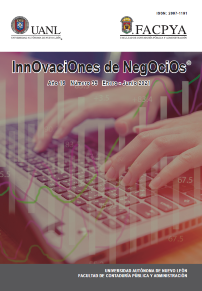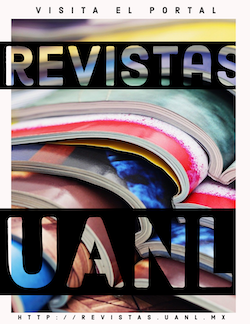Organizational factors that influence on work stress of teaching staff of universities in the Metropolitan Area of Monterrey
DOI:
https://doi.org/10.29105/rinn18.35-e6Keywords:
job stress, higher education, work overload, job insecurityAbstract
Having a paid job is, for most people's work, a source of economic security, status, well-being and health. It gives meaning to their lives, but at times it can be a physical and / or mental burden, and a source of frustration, conflict, disappointment, physical and mental discomfort, and even death (Lundberg & Cooper, 2011). These discomforts are sometimes referred to as job pressure, or better known as job stress (Wainwright & Calnan, 2002). The purpose of this
study is to analyze how five specific organizational factors impact on the job stress of teaching staff in higher education institutions in the Metropolitan Area of Monterrey. The results that will be obtained from this research will serve the
universities for the planning of strategies to prevent work stress, which has negative consequences at the individual and organizational level.
Downloads
References
Abbott, A. (2001). Chaos of Disciplines. The University of Chicago Press.
Abouserie, R. (1996). Stress, coping strategies and job satisfaction in university
academic staff. Educational Psychology, 16, 49-56.
Baker, R. (1985). The study of stress at work. Annual Review of Public Health,
, 367-381.
Bass, B. y Bass, R. (2008). The bass handbook of leadership: theory, research
& managerial applications. New York: The Free Press.
Bell, A. S., Rajendran, D. y Theiler, S. (2010). Job stress, Wellbeing, Work-life
balance and Work-life Conflict Among Australian Academics.
Electronic Jouornal of Applied Psychology, 8(1), 25-37.
Bowling, N. A. y Kirkendall, C. (2012). Workload: a Review of Causes,
Consequences, and Potential Interventions. Contemporary
Occupational Health, 221-238.
Bowling, N. A., Alarcon, G. M., Bragg, C. B. y Hartman, M. J. (2015). A metaanalytic examination of the potential correlates and consequences of
workload. Work & Stress, 1-19.
Boyd, C. M., Bakker, A. B., Pignata , S., Winefield, A. H., Gillespie, N. y Stough,
C. (2011). A longitudinal test of the job demands-resources model
among Australian university academics. Applied Psychology: An
International Review, 60,112-140.
Cox, T. y Griffiths, A. (2010). Work-Related Stress. A Theoretical Perspective.
In S. Leka & J. Houdmont, Occupational health psychology (31-56).
Oxford: Blackwell Publishing Ltd.
Cranwell-Ward, J. y Abbey, A. (2005). Organizational Stress. Wales: Palgrave
MacMillan.
Cross, G. y Carroll, D. (1990). Goodwill under stress: morale in UK universities.
London: Association of University Teachers.
Darabi, M., Macaskill, A. y Reidy , L. (2016). Stress among UK academics:
identifying who copes best. Journal of Further and Higher Education,
(3), 393-412.
Dicke, T., Parker, P. D., Marsh, H. W., Kunter , M., Shcmeck, A. y Leutner, D.
(20114). Self-efficacy in clasrrom management, cassroom
disturbances, and emotional exhaustion: a moderated mediation
analysis of teacher candidates. Journal of Educational Psychology,
, 569-583.
DOF. (2018). NOM-035-STPS. Ciudad de México.
Dollard, M. F., Winefield, A. H. y Winefield, H. R. (2003). Occupational Stress
in the Service Professions. London: Taylor & Francis Group.
Early , P. (1994). Lecturer's workload and factors affecting stress levels.
Slough: NFER.
Gallup. (2014). State of America's schools: the path to winning againin
education. Washington: Gallup.
Goodell, H., Wolf, S. y Rogers, F. B. (1986). Historical Perspective, Chapter 2.
In S. Wolf & A. J. Fineston, Ocupational Stress. Health and
Performance at Work. Littleton: MA: PSG Inc.
Guillespie, N. A., Walsh, M., Winefield, A. H., Dua, J. y Stough, C. (2001).
Occupational stress in universities: staff perceptions of the causes,
consequences and moderators of stress. Work and Stress, 15, 53-72.
Hakanen, J. J., Bakker, A. B. y Schaufeli, W. B. (2006). Burnout and work
engagement among teachers. Journal of School Psychology, 43, 495-
Heranshaw, L. S. (1987). The shaping of modern psychology. London:
Routledge and Kegan Paul.
Humphrey, J. H. (1998). Job Stress. Upper Saddle River: Pearson Education.
Idris, M. K. (2011). Over time effects of role stress on psychologycal stress
among malasian public university academics. International Journal of
Business and Social Science, 154-161.
ILO. (2016). Workplace Stress: a collective challenge. Turin: International
Training Centre.
Johnson, S., Cooper, C., Cartwright, S., Donald, I., Taylor, P. y Millet, C. (2005).
The experience of work-related stress across occupations. Journal of
Managerial Psychology, 20(2), 178-187.
Judge, T. A. y Colquitt, A. (2004). Organizational justice and stress: the
mediating role of work-family conflict. Journal of applied psychology,
-404.
Kahn, R. L. y French , J. P. (1962). A summary and some tentative conclusions.
Journal of Social Issues, (18), 122-127.
Khan, R. L. (1970). Some propositions towards a researchable
conceptualization of stress. Social and Psychological Factors in
Stress, 97-103.
Kinman, G. (2001). Pressure points: a review of research on stressors and
strains in UK academics. Educational Psychology, 21, 473-492.
Kinman, G. (2016). Effort-reward imbalance and overcommitment in IK
academics. Journal of Higher Education Policy and Management, 1-
Kinman, G. y Jones, F. (2003). 'Running up the escalator': Stressors and strains
in UK academics. Quality in Higher Education, 9(1), 21-38.
LePine, M. A., Zhang, Y., Crawford , E. R. y Rich, B. L. (2016). Turning their
pain to gain: Charismatic leader influence on follower stress appraisal
and job performance. Academy of Management Journal, 59(3), 1036-
Lundberg, U. y Cooper, C. (2011). The science of occupational health: stress,
psychobiology and the new world of work. United Kingdom: WileyBlackwell.
Mudrak, J., Zabrodska, K., Kveton, P., Jelinek, M., Blatny, M., Solcova, I. y
Machovcova, K. (2017). Occupational Well-Being Among University
Faculty: a Job-Demands Resources Model. Research in Higher
Education, 1-24.
Narayanan, L., Menon, S. y Spector, P. E. (1999). Stress in the workplace: a
comparison of gender and occupations. Journal of Organizational
Behavior, 20(1), 63-73.
Newton, T. (1995). "Managing Stress: Emotion and Power at Work. London:
Sage.
OIT. (5 de Marzo de 2020). Historia de la OIT. https://www.ilo.org/global/aboutthe-ilo/history/lang--es/index.htm
Panatik, S. A., Rajab, A., Shah, I. M., Rahman, H. A., Yusoff, R. M. y Badri, S.
B. (2012). Work-family conflict, stress and psycholgical strain in higher
education. International Conference on Education and Management
Inovation, 30, 67-71.
Peiró, J. M. y Rodríquez, I. (2008). Estrés laboral, liderazgo y salud
organizacional. Papeles del psicólogo, 68-82.
Pettit, L. (21 de Octubre de 2003). "Who's the most stressed of all?," . Obtenido
de Personnel Today.
Robertson, I. y Cooper, C. L. (2004). Premiership of pressure-Britain's most
stressful jobs. www.robertsoncooper.com/pdf/stressfuljobs
Roeser, R. W., Schonert-Reichl, K., Jha, A., Cullen, M., Wallace, L. y Wilensky,
R. (2013). Mindfulness training and reductions in teacher stress and
burnout: Results from two randomized, waitlist-control field trials.
Journal of Educational Psychology, 105, 787-801.
Sernicharo, M. G. y Chávez, M. M. (2020). El empleo en México. 2012-108.
Pluralidad y Consenso, 8(37), 28-45.
Siegrist, J. (2016). Work stress and health in a globalizaed economy. The
model of Effort-Reward Imbalance. Springer.
STPS. (25 de Octubre de 2008). Estadísticas del sector.
https://www.inegi.org.mx/contenidos/programas/enesccom/doc/Estadi
sticas%20Laborales.pdf
Stranks, J. (2005). Stress at Work. Oxford: Elsevier Butterworth-Heinemann.
Tacca-Huanmán, D. R. y Tacca-Huanmán, A. L. (2019). Factores de riesgo
psicosociales y estrés percibido en docentes universitarios. Propósitos
y Representaciones, 7(3), 323-353.
Vong, L. T.-N., Ngan, H. F. y Lo, P. C.-P. (2018). Does organizational climate
moderate de relationship between job stress and intent to stay?
Journal of Chinese Human Resources Management, 9(1), 2-20.
Wainwright, D. y Calnan, M. (2002). Work stress. The making of a modern
epidemic. Philadelphia: Open University Press.
Weinberg, A., Sutherland, V. J. y Cooper, C. (2010). Organizational stress
management. A strategic aproach. New York: Palgrave Macmillan.
Winefield, A. H., Boyd, C., Seabel, J. y Pignata, S. (2008). Update on a National
University Stress Study. Australian Universities Review, 50, 20-29.
Winefield, A. H., Guillespie, N. A., Stough, C. K., Dua, J. K. y Hapuarachchi, J.
R. (2002). Occupational stress in Australian Universities. A national
survey 2002. Australia: National Tertiary Education Union Publication.
Downloads
Published
How to Cite
Issue
Section
License
Copyright (c) 2021 Innovaciones de Negocios

This work is licensed under a Creative Commons Attribution-NonCommercial-ShareAlike 4.0 International License.
The InnOvaciOnes de NegOciOs magazine is a free and open access electronic magazine of a scientific-academic nature and is a publication of the Autonomous University of Nuevo León, in which the authors retain their copyright and grant the magazine the exclusive right to first publication of the work. Third parties are allowed to use the published content, as long as the authorship of the work is acknowledged and the first publication in this journal is cited.
For more information, please contact the Research Secretary (FACPyA) of the Autonomous University of Nuevo León. Telephone: (81) 1340-4430. Email: revinnova@uanl.mx










